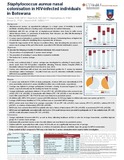Staphylococcus aureus nasal colonisation in HIV-infected individuals in Botswana
Date
2014-08-20Author
Fischer, Rebecca S.B.
Reid, Michael J.A.
Mannathoko, Naledi
Brown, Eric L.
Steenhoff, Andrew P.
Type
Conference/Seminar PaperMetadata
Show full item recordAbstract
Background: Despite the huge burden of HIV disease, data describing the prevalence of Staphylococcus aureus nasal carriage in the setting of HIV infection in southern Africa are sparse.
Objective: This cross-sectional study sought to estimate the prevalence of S. aureus nasal carriage and define risk factors for colonization among HIV-infected individuals in southern Botswana.
Design: 418 HIV-infected individuals (116 men, 302 women) were screened twice for nasal carriage of methicillin-susceptible (MSSA) and methicillin resistant (MRSA) S. aureus over a 4-week interval at two outpatient facilities. S. aureus carriage was further defined as either intermittent (carriage at one visit but not both) or persistent (carriage at both visits). Nasal carriage was related to demographic characteristics, HIV parameters, co-morbidities, and exposure to health care services.
Results: Prevalence of nasal colonization for S. aureus was 38% (n=158); 49% (n=78) were intermittent carriers, 51% (n=80) persistent carriers. Prevalence of intermittent MRSA carriage was 3% (n=13); no patients were persistently colonized by MRSA. Those > 18 years were less likely to be persistent carriers than those < 18 years (Prevalence Ratio [PR] 0.41, p=0.003). Those accessing care at a semi-rural facility (PR 2.19, p=0.005), sharing households with ≥1 child (PR 1.36, p=0.06) and those with elevated viral loads (>399 copies/mL) (PR 1.88, P=0.019) were also more likely to be persistent carriers than non-carriers.
Those with MRSA were more likely to be <18 years old (PR 0.12, p<0.05) and have history of eczema (PR 5.72, p=0.001), asthma (PR 3.75, p<0.05), tuberculosis (PR 3.26, p=0.03), or pneumonia (PR 3.6, p=0.03).
Neither MSSA nor MRSA was significantly associated with viral load or CD4 count. However, MRSA was more prevalent than MSSA among those on third line (PR 4.52, p=0.08) antiretroviral regimes and those with detectable viral loads (PR 1.67, p=0.052).
Conclusion: HIV-infected children, persistent viremia and those living in semi-rural and larger households constitute high-risk groups for nasal carriage for S. aureus. Intermittent MRSA carriage was more prevalent among younger patients with unsuppressed viremia and co-morbid diseases. Persistent nasal MRSA colonization among non-hospitalized HIV-infected persons was negligible.

